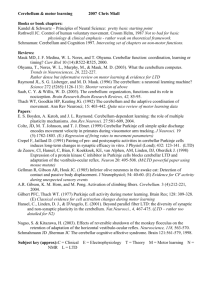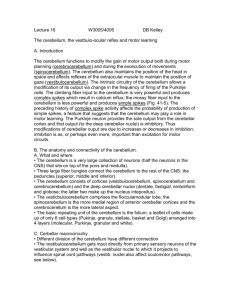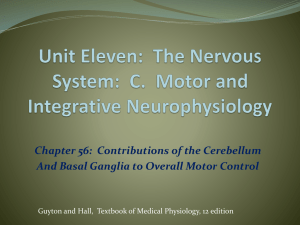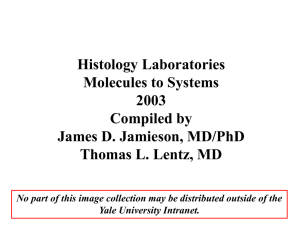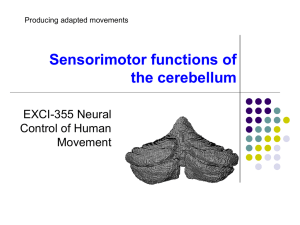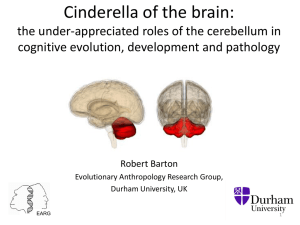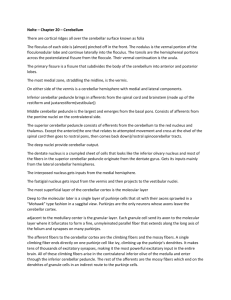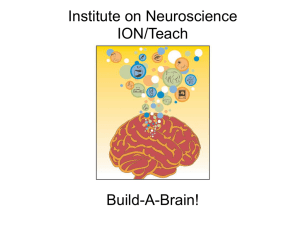Cerebellum_seminar
advertisement
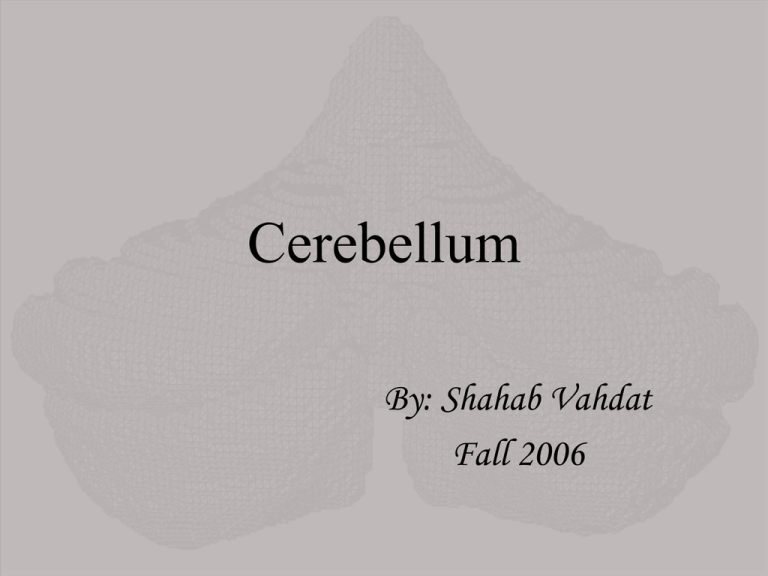
Cerebellum By: Shahab Vahdat Fall 2006 General View Cerebellum (Latin, little brain): only 10 % total volume of the brain but more than half of all its neurons. arranged in a highly regular manner as repeating units but with input and outputs from different parts similar computational operations but on different inputs. the cerebellum is provided with extensive information (40 times more axons project into the cerebellum than exit from it) three sections of cerebellum: (i) gray matter: cerebellar cortex (ii) white matter (iii) 3 deep nucleus: fastigial, interposed, dentate. the cerebellum is not necessary to basic elements of perception or movement. damage to the cerebellum disrupts the spatial accuracy and temporal coordination of movement. It impairs balance and reduces muscle tone and motor learning and certain cognitive functions. Inputs and Outputs of Cerebellum General View Gross features of the cerebellum, including the nuclei, cerebellar peduncles, lobes, folia, and fissures. (Adapted from Nieuwenhuys et al. 1988) A. Dorsal view. Part of the right hemisphere has been cut out to show the underlying cerebellar peduncles. B. Ventral view of the cerebellum detached from the brain stem. C. Midsagittal section through the brain stem and cerebellum, showing the branching structures of the cerebellum. The Cerebellum Has Three Functionally Distinct Regions The cerebellum is divided into anatomically distinct lobes. A. The cerebellum is unfolded to reveal the lobes normally hidden from view. B. The main body of cerebellum has three functional regions: the central vermis and the lateral and intermediate zones in each hemisphere. It is divided by the primary fissure into anterior and posterior lobes. The posterolateral fissure separates the flocculonodular lobe. Shallower fissures divide the anterior and posterior lobes into nine lobules (anatomists consider the flocculonodular lobe as the tenth lobule). The Cerebellum Has Three Functionally Distinct Regions The Cerebellum Has Three Functionally Distinct Regions The three functional regions of the cerebellum have different inputs and outputs. Neurons in the Cerebellar Cortex Are Organized into Three Layers The cerebellar cortex is organized into three layers and contains five types of neurons. A vertical section of a single cerebellar folium, in both longitudinal and transverse planes, illustrates the general organization of the cerebellar cortex. The detail of a cerebellar glomerulus in the granular layer is also shown. A glomerulus is a clear space where the bulbous terminal of a mossy fiber makes synaptic contact with Golgi and granule cells. Neurons in the Cerebellar Cortex Are Organized into Three Layers The Purkinje Cells Receive Excitatory Input From Two Afferent Fiber Systems and Are Inhibited by Three Local Interneurons Synaptic organization of the basic cerebellar circuit module. Mossy and climbing fibers convey output from the cerebellum via a main excitatory loop through the deep nuclei. This loop is modulated by an inhibitory side-loop passing through the cerebellar cortex. This figure shows the excitatory (+) and inhibitory (-) connections among the cell types. Geometrical Plan of Parallel and Climbing fibers The geometry of the mossy and parallel fiber system contrasts with that of the climbing fiber system. Mossy fibers excite granule cells whose parallel fibers branch transversely to excite hundreds of Purkinje cells several millimeters from the branch point, both medially and laterally. By contrast, climbing fibers branch in the sagittal dimension to excite 10 or so Purkinje cells anterior and posterior to the branch point. The transverse connections of the parallel fibers and the sagittal connections of the climbing fibers thus form an orthogonal matrix. Mossy and Climbing Fibers Encode Peripheral and Descending Information Differently Simple and complex spikes recorded intracellularly from cerebellar Purkinje cells. Complex spikes (right bracket) are evoked by climbing fiber synapses, while simple spikes (left bracket) are produced by mossy fiber input. (From Martinez et al. 1971.) Synchronization of complex spikes in the Purkinje neurons A. A rat performing trained licking. B. The grid represents the spatial locations of 29 Purkinje cells from which complex spikes were recorded while the rat was licking. The cells in red fired synchronously at one time; those in blue fired synchronously at another time; cells represented by open circles were not synchronized. Synchronous complex spikes occurred in neighboring Purkinje cells even after the peripheral nerves from the face had been sectioned, suggesting that the synchronized firing was central in origin. (from Welsh et.al. 1995 Nature) Climbing Fiber Activity Produces Long-Lasting Effects on the Synaptic Efficacy of Parallel Fiber Some models of the cerebellum in learning movements: 1. Marr and Albus primary model 2. Forward dynamics model based 3. APG model 4. APPG model of the Cerebellum : (APG + Motor primitives of spinal cord) Cerebellum as a forward model: Theoretical and neural organization of forward models. a( Theoretical organization of information processing streams that use forward models for motor control. Motor commands directed to systems that control movement are also copied to forward models that mimic input–output relationships exhibited by these systems (blue, direct route; red, side-loop). b( Anatomical correlates of this theoretical organization. Note that the anatomical model contains additional components that exert control over motor control systems (for example, by modulating rubrospinal circuits) (RN, red nucleus). c (Analogous anatomical model involving prefrontal interactions. The organization is the same as that in panel b. Information arising in the prefrontal cortex is copied to the cerebellum in the same way that motor commands are copied from the primary motor cortex to the spinal cord. In this scheme, cerebellar forward models mimic the input–output relationships of prefrontal targets (note that the target of a prefrontal neuron can be neurons outside the prefrontal cortex, but can also be another prefrontal neuron). Forward models might therefore be able to mimic information processing that is intrinsic to the prefrontal cortex. APG model of the Cerebellum: • Proposed by Houk and Barto in 1989 (Adjustable pattern generator) • Produces motor commands with adjustable duration and intensity • completely agree with physiological aspects of the cerebellum • Positive feedback pathway between cerebral cortex and cerebellar nuclei • PC receives input from PF,CF and basket cells APG model: Phases of movement : 1. Programming : balance between PF and BS determines the situation of PC 2. Initiation : spread of positive feedback in premotor networks 3. The intensity of command (positive feedback) is determined by the situation of PC and this produces different elemental movements 4 . PC becomes refractory to further inputs until near end of movement 5 . The movement is terminated by firing a large number of PCs which were turned off in programming phase due to PF inputs 6 . CF modifies synaptic weights in programming phase and in termination phase due to PF patterns Isometric force fields Motor primitives in the Spinal Cord Force fields evoked from microstimulation of the interneuronal regions of the frog spinal cord. a, The ankle of spinalized frogs was attached to a force transducer and fixed at different locations in the workspace of the leg, indicated by the filled circles in the figure. The same site in the spinal cord was electrically stimulated with the ankle in each location, and the resulting isometric force was measured. b, shows an example of a force field resulting from the stimulation of one such site in the spinal cord. Reproduced from Bizzi and others (1991). Linear Summation Principle Vector summation of force vectors when costimulating ites at different activation levels. The top panel shows the ndividual fields obtained when site A was stimulated at the ower pulse duration (PD) and site B at the higher one, and the actual (site A and B activated simultaneously) and predicted (from linear summation of the forces at each position) fields obtained from costimulation of the two sites. The bottom panel shows the results when the levels of activation were switched. Similarity between fields is indicated by a black arrow indicating no difference in average angular deviation across the measured vectors, and a white arrow indicating that the force magnitude ratio across positions is not different than 1. The fields produced by the two combinations of activation levels (top and bottom panel) were different from each other, showing the possibility of creating a variety of fields by modulating the contribution of each original site to the summated response. Reproduced from Lemay and others (2001). • Responses generated by combinations of muscle synergies may show low correlation between the activities of muscle pairs. A muscle synergy is defined here as the recruitment of a group of muscles with a specific balance of activation. If only one synergy is activated at a time (a), a set of responses obtained by changing the level of activation of a synergy is obtained by scaling a single vector in the muscle activity space (b). In this case, all pairs of muscles have highly correlated activations (c). If instead two synergies are coactivated (d), the set of responses are generated by combining two vectors and the activities of the muscles lie on a plane (e). The correlation between two of the three muscles is now much lower (f). Brain Spinal cord solving the inverse problem (t) = G-1(q(t)) = S ci i(q(t)) Linear interaction APPG model of the Cerebellum APPG model : Figure illustrates the scheme of our proposed model for cerebellar learning based on APPG modules. Primitive encoder represents the Granule cells, which provide cerebellum with sparse expansive encoding of the coefficients of primitives (ci ) from the spinal cord and motor cortex. A map transforms a low dimensional variable q(t) into a multi-dimensional control signal; input of this transformation is the proprioceptive information of the motor apparatus and the output represents the mossy fiber. This process is performed in “state mapping” block shown in Fig. The Cn represents the current coefficient of motor primitive that corresponds to the efferent copy of motor information coming from spinal cord to the cerebellum. Cn+1 represents the information from motor cortex to the cerebellum (equivalent to next motor coefficient). [q,q’]n-1 represents the proprioceptive information from the limbs (the previous state of the limb).
